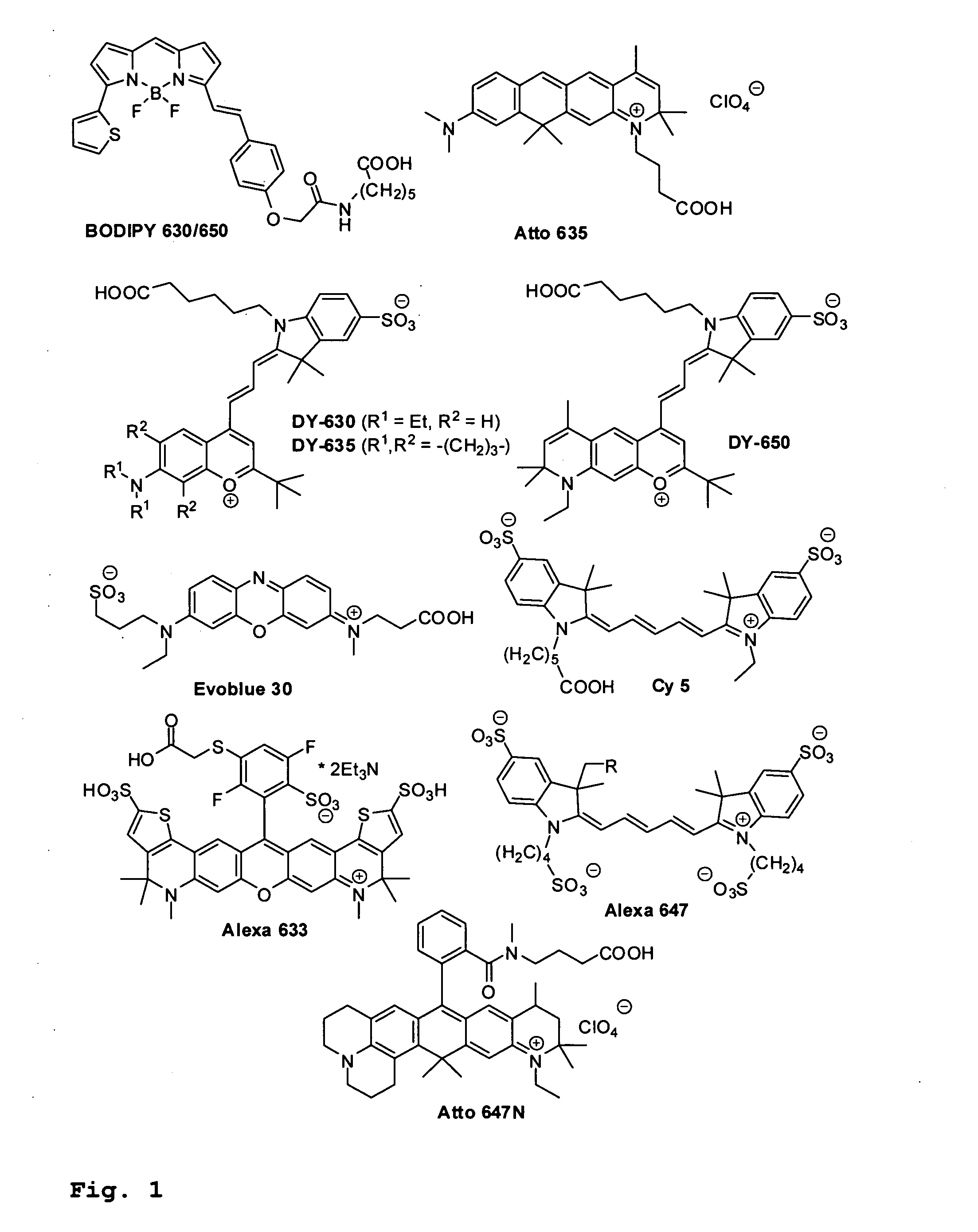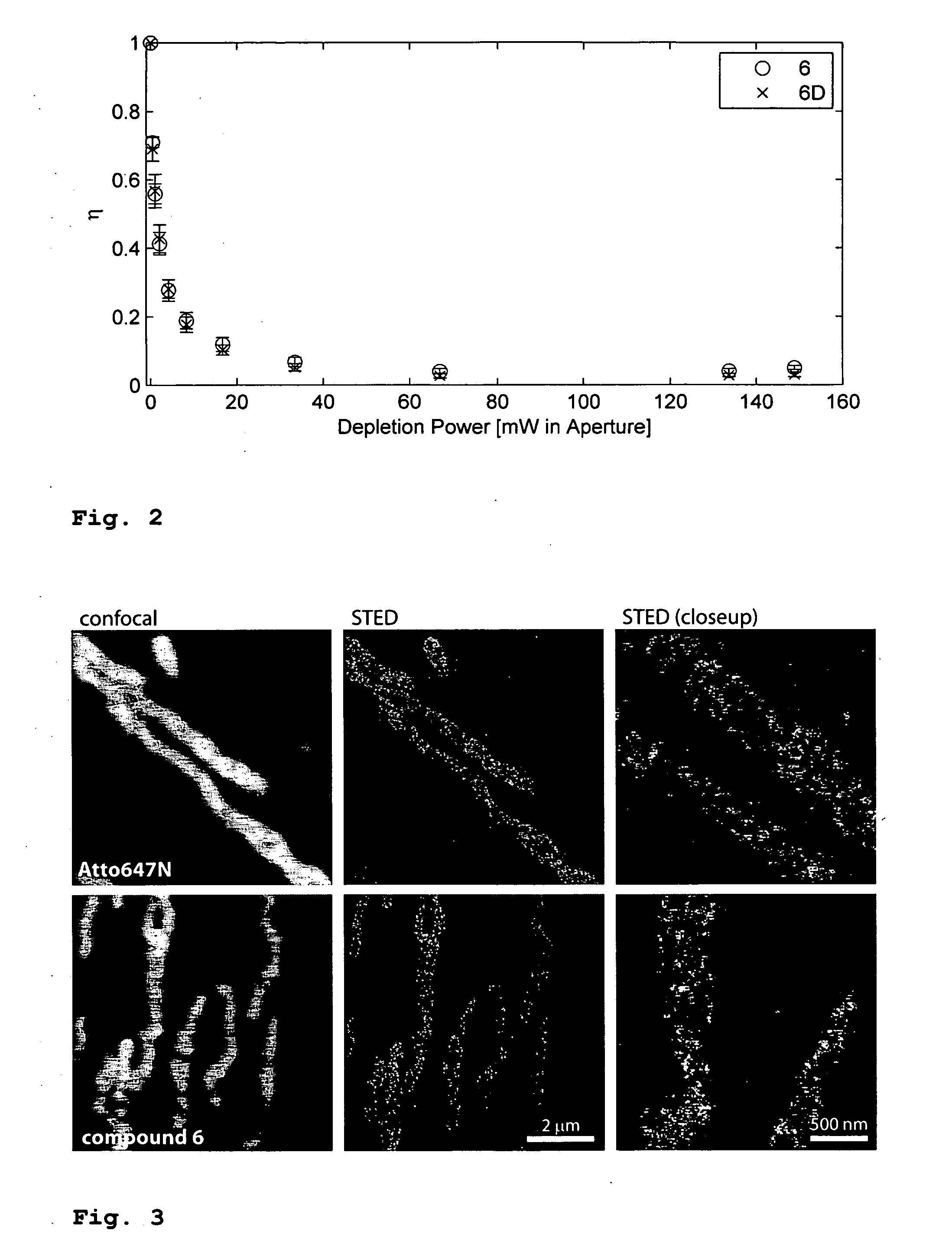Novel hydrophilic and lipophilic rhodamines for labelling and imaging
a lipophilic rhodamine and labelling technology, applied in the preparation of sugar derivatives, chemiluminescene/bioluminescence, peptides, etc., can solve the problems of low coupling efficiency, photobleaching of fluorophores, and substantial drawbacks of bodipy® derivatives
- Summary
- Abstract
- Description
- Claims
- Application Information
AI Technical Summary
Problems solved by technology
Method used
Image
Examples
example 2
Synthesis of Deuterated Rhodamine Compounds
[0075]Deuterated analogue of compound 1. The method for the preparation of 1 outlined by L. A. Robinson and M. E. Theoclitou [Tetrahedron Lett. 2002, 43, 3907-3910] was used utilizing [D6]-acetone as a starting material. An additional treatment of the evaporated reaction mixture with MeOD in order to “restore” the methine deuterium atoms in the fragment CCD3=CD was necessary. They proved to be largely (and unexpectedly) exchanged to H in the course of the synthesis. Presumably, the methine groups coordinate to the ytterbium catalyst and then receive protons from H2O formed in the course of the reaction or added during the work-up.
[0076]Finely powdered ytterbium(III) triflate (the commercially available hydrate, 1.30 g, ˜26 mmol) was dried in a Schlenk flask with stirring at 130° C. for 1.5 h. Then the flask was filled up with argon, cooled to 0° C., and a solution of m-anisidine (1.75 g, 14 mmol) in [D6]-acetone (92 mL, 1.14 mol) was added ...
example 3
Microinjection Tests of Compound 6 and of the Commercial Dye Atto 647N
[0079]The commercial dye Atto 647N is preferred in many fluorescence microscopy studies, especially when high excitation powers are used. It has a superior photo stability compared to other dyes. For live cell studies, it is desirable to introduce aqueous solutions of the dye (e.g. coupled to antibodies) via microinjection into cells. However, it was found that this is impossible with the Atto 647N dye because it is too lipophilic and sticks to the walls of the glass capillaries used for injection. These tests were performed with a ˜0.5 μM solution of Atto 647N in water or PBS, filled into microinjection pipettes (Femtotips®, Eppendorf, Hamburg, Germany and home made capillaries). The capillaries got blocked by the dye and no fluid could be injected, even under the maximally available pressure of ˜4000 hPa. The walls, but not the interior of the capillaries brighten up when irradiated. On the other hand, if 50% (v...
example 4
Stimulated Emission Depletion Studies
[0081]The bleaching resistance of rhodamine 6 and the commercial dye Atto647N were compared in (fixed) biological samples. Both dyes (as NHS esters) were coupled to goat-anti-rabbit antibodies (Dianova, Hamburg, Germany), and these were used for staining the mitochondrial protein Tom20 in mammalian cells (cell line U2OS). A Tom20 specific antibody (from rabbit) (Santa Cruz Biotechnology, Heidelberg, Germany) was used as a primary label. From 50 up to 100 frames were imaged from the same region. The bleaching stability was determined by exponential fits to the fluorescence intensity in selected regions of interest. It was found that the bleaching stability of compound 6 under excitation by light of 635 nm followed by depletion at 750 nm (used in STED microscopy) is comparable with the commercial dye Atto 647N. However, excitation with 635 nm light alone (without depletion at 750 nm) revealed that under these conditions the photostability of dye 6 ...
PUM
| Property | Measurement | Unit |
|---|---|---|
| wavelengths | aaaaa | aaaaa |
| fluorescence quantum yields | aaaaa | aaaaa |
| temperature | aaaaa | aaaaa |
Abstract
Description
Claims
Application Information
 Login to View More
Login to View More - R&D
- Intellectual Property
- Life Sciences
- Materials
- Tech Scout
- Unparalleled Data Quality
- Higher Quality Content
- 60% Fewer Hallucinations
Browse by: Latest US Patents, China's latest patents, Technical Efficacy Thesaurus, Application Domain, Technology Topic, Popular Technical Reports.
© 2025 PatSnap. All rights reserved.Legal|Privacy policy|Modern Slavery Act Transparency Statement|Sitemap|About US| Contact US: help@patsnap.com



